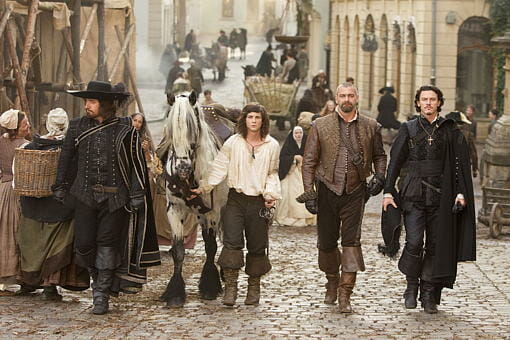By Ryan Mason · October 24, 2011

Going into yet another big-budget version of Alexandre Dumas’ swashbuckling classic, The Three Musketeers, one wonders just what more could be done that hadn’t yet been seen on the big screen with this story of three wisecracking swordsmen who work for King Louis XII in 17th century France. Thankfully, director Paul W.S. Anderson resolves that quandary definitively: airships!
I know I personally had watched the Brat Packs’ 1993 version feeling like something was missing. Something that would enhance the story and visuals while also remaining faithful to the period in which the film takes place. You know, traditional sailing ships attached to huge balloons, which make them fly. Eat that, Dumas. Talk about a lack of vision on the part of the French author and all those dozens of filmmakers before now who just couldn’t capitalize on a decent premise by taking it to its logical manifestation of having dirigibles created from Da Vinci’s notebook sketches.
Anderson (Event Horizon, Resident Evil) isn’t known for being a subtle filmmaker, so none of this should be all that surprising. What is, however, is that, tonally, The Three Musketeers is far and away Anderson’s lightest film. Of course, the story lends itself to comedy more than serious adventure, with the titular heroes – Aramis (Luke Evans), Athos (Matthew Macfadyen), and Porthos (Ray Stevenson) — acting all curmudgeonly, while the young D’Artagnan (Logan Lerman) comes across exceedingly overconfident, cracking wise while parrying attackers blows effortlessly. And it’s kind of fun to an extent. Kind of. It’s clear that Anderson isn’t taking this – nor are any of the actors, who are all quite good, actually – too seriously, which is key, because if they had, it would’ve been unbearable. The film is far from good, but it rides that line of so-bad-it’s-almost-fun. Most of the runtime.
And that’s pretty much par for the course from movies by the British director, who reins in his usual penchant for graphic violence in this quite tame PG-13 spectacle. With him at the helm, before I stepped into the theater, I expected those swordfights to culminate in blood-spurting sheared limbs; instead, the violence is cartoonish and child-friendly. (As far as “child-friendly” goes these days, which is to say that it’s still quite violent but without the nasty realism of just what would happen should you be run-through with a long blade – hilariously exemplified when D’Artagnan stabs Rochefort in the stomach, the wound barely a scratch, yet it somehow [spoiler alert] kills him.) This makes it his most accessible film as far as being available to a broader age range, but it also makes it rather neutered.
The last flick he did that wasn’t rated R happen to be his Hollywood debut, Mortal Kombat, which was also aimed at the same audience that’s ideal for this one: teenage boys. Although based on the reaction of the group of high-schoolers that sat down the row for me on Friday night, I’m not sure that it’s quite what they were looking for. It just wasn’t funny or clever enough with the dialogue, the action wasn’t nearly exciting enough, and the love stories never compelling enough to elicit anything more than some chuckles – and outright laughs – at spots that shouldn’t have been humorous by design. Although, after a short while, even though it wasn’t as funny when it was supposed to be, it was amusing enough unintentionally to keep you entertained should you be forced to see it. But, please don’t take this to mean that you should volunteer.
The visuals weren’t great, and I admit I didn’t see the 3D version, so I can’t speak to the quality of those effects, although I can’t imagine they could’ve been all that amazing. Anderson used plenty of poorly rendered green-screen shots, especially near the end when D’Artagnan duels with Rochefort (Mads Mikkelsen) on top of a building. Any thrills to be gained from believing that they were truly inches away from falling to their deaths were thrown out the window with the truly fake-looking effects. And that’s if you weren’t already laughing at the just absurdly weak flesh wound that gets the best of the most feared swashbuckler of them all. Yet, somehow Anderson managed to put together a decent battle sequence between the flying airships, which was thankfully tauter than anything in the last three Pirates of the Caribbean films even if it borrowed from them, especially that never-ending final scene in At World’s End.
All things considered, perhaps that’s the main reason The Three Musketeers wasn’t awful: it mercifully only lasted two hours, not three. Unfortunately, that’s not much of a winning endorsement.